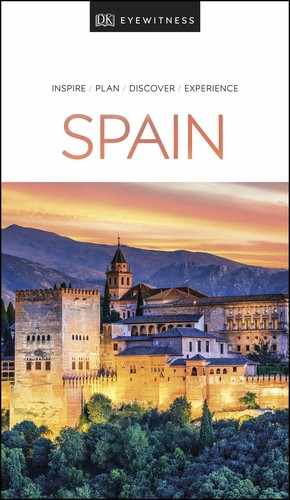Experience More
This little town will always be remembered for being the target of the world’s first saturation bombing raid, carried out by Nazi aircraft at Franco’s request on 26 April 1937. Picasso’s powerful painting of the bombing hangs in Madrid, but the town’s Museo de la Paz de Gernika examines the event and its aftermath.
It is important to remember that Gernika-Lumo had an illustrious history before this infamous event. For centuries, Basque leaders met in democratic assembly under an oak on a hillside here. Known as the Gernikako Arbola, or Oak of Gernika, the tree’s 300-year-old petrified trunk has become a site of pilgrimage for the Basque people.
The Casa de Juntas, nearby, is a former chapel where the parliament of the province of Vizcaya reconvened in 1979, when the Basque provinces regained their autonomy. A stained-glass ceiling depicts Basque citizens debating under the Gernikako Arbola.
The Europa Park, next door, has peace sculptures by Henry Moore and Eduardo Chillida.
Five km (3 miles) northeast of Gernika are the Cuevas de Santimamiñe. On the walls of a small chamber are charcoal drawings of animals made by cave dwellers around 11,000 BC, discovered in 1917. For conservation reasons the caves are closed to the public, but there is an impressive 3D simulation in the nearby hermitage and replicas of the drawings are projected on the walls of the entrance. Guided visits last 90 minutes and must be booked in advance.
" '
Museo de la Paz de Gernika
⌂ Foru Plaza 1 # Hours vary, check website ¢ Jan ∑ www.museodelapaz.org
'
Casa de Juntas
⌂ Calle Allende Salazar § 946 25 11 38 # 10am–2pm & 4–6pm daily ¢ 1 & 6 Jan, 16 Aug, 24, 25 & 31 Dec
" '
Cuevas de Santimamiñe
⌂ Kortézubi § 944 65 16 57 # May–Sep: 10am–5:30pm daily; Oct–Apr: 10am–1pm Tue–Sun

t A stained-glass ceiling showing the Oak of Gernika at Casa de Juntas
Hondarribia (Fuenterrabía), the historic town at the mouth of the Río Bidasoa, was attacked by the French over many centuries. The upper town is protected by 15th-century walls and entered via their original gateway, the handsome Puerta de Santa María. They enclose alleys of old houses with carved eaves, balconies and coats of arms.
The streets cluster round the church of Nuestra Señora de la Asunción y del Manzano, with its massive buttresses, tall Baroque tower and, inside, a gold reredos. At the town’s highest point is the 10th-century castle, now a parador.
Hondarribia has seafront cafés in La Marina, its fishermen’s quarter, and beaches stretching to the north.
Did You Know?
Minke whales can sometimes be spotted along the Costa Vasca.
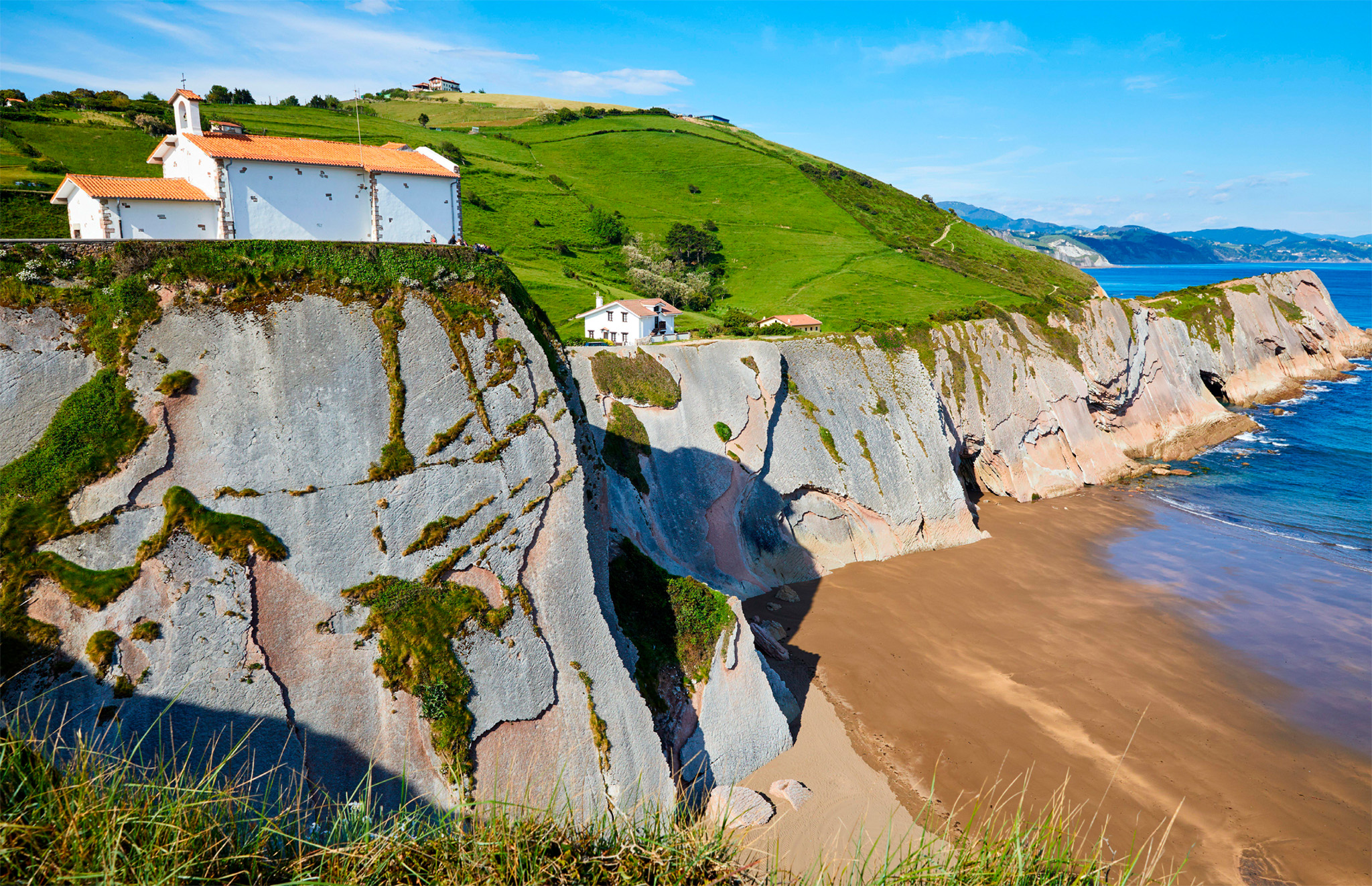
t The rugged rocky coastline of the Costa Vasca
This 176-km- (110-mile-) long coastline is heavily indented: rugged cliffs alternate with inlets and coves, backed by wooded hills.
Eastwards on the coast is Bakio, a large fishing village. Beyond it the BI-3101 winds high above the sea past the tiny island hermitage, San Juan de Gaztelugatxe, and Matxitxaco, a headland light- house. It passes Bermeo, a port with a fishery museum – the Museo del Pescador.
At Lekeitio, Basque houses line the seafront below the 15th-century church of Santa María. One long beach sweeps round the village of Saturrarán and the old port of Ondarroa.
In Zumaia is the Espacio Cultural Ignacio Zuloaga, the former home of the well-known Basque painter who lived here from 1870 to 1945. Studies of Basque rural and maritime life are on display. Getaria, along the coast, is spread steeply around a fishing port, and has lively cafés.
"
Museo del Pescador
⌂ Plaza Torrontero 1, Bermeo § 946 88 11 71 # 10am–2pm & 4–7pm Tue–Sun ¢ Public hols
" '
Espacio Cultural Ignacio Zuloaga
⌂ Santiago Etxea 4, Zumaia § 677 07 84 45 # Apr–Sep: 4–7:30pm Wed–Sun; other times by appt
EXPERIENCE The Basque Country, Navarra and La Rioja
|
Stay La Casa de los Arquillos Once a tailor’s workshop, this hotel has light and airy rooms. ⌂ Calle de Los Arquillos 1–2, Vitoria ∑ lacasadelosarquillos.com ¡¡¡ Parador de Hondarribia A 10th-century castle, with sunny terraces. ⌂ Plaza de Armas 14, Hondarribia ∑ parador.es ¡¡¡ Hotel Los Agustinos Set in a former convent, this hotel has kept its historic charm. ⌂ San Agustín 2, Haro ∑ hotellosagustinos.com ¡¡¡ |
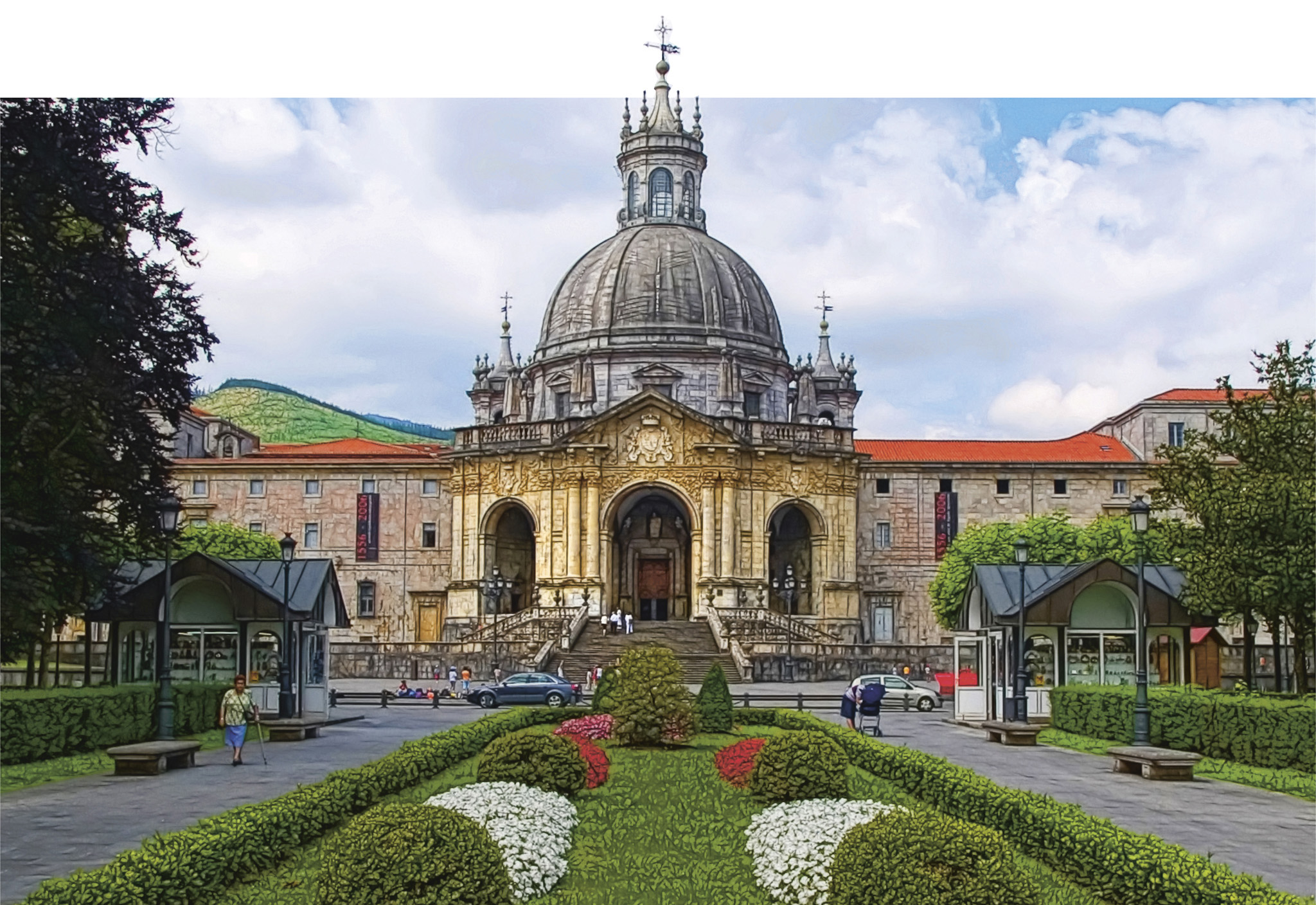
t The imposing basilica of the Santuario de Loiola, topped by
Saint Ignatius of Loiola (San Ignacio de Loyola), founder of the Jesuits, was born in the 1490s in the Santa Casa (holy house), a stone manor near Azpeitia. In the 1600s it was enclosed by the Basílica de San Ignacio, and the rooms in which the aristocratic Loiola family lived were converted into chapels. The Chapel of the Conversion is where Ignatius, as a young soldier, rested while he recovered from a war injury and had a profound religious experience.
A diorama depicts episodes in the saint’s life: dedicating his life to Christ at the Monastery of Montserrat; writing his Spiritual Exercises in a cave at Manresa; his imprisonment by the Inquisition; and his pilgrimage to the Holy Land. The basilica, built from 1681 to 1738, has a Churrigueresque dome and a circular nave with rich carvings.
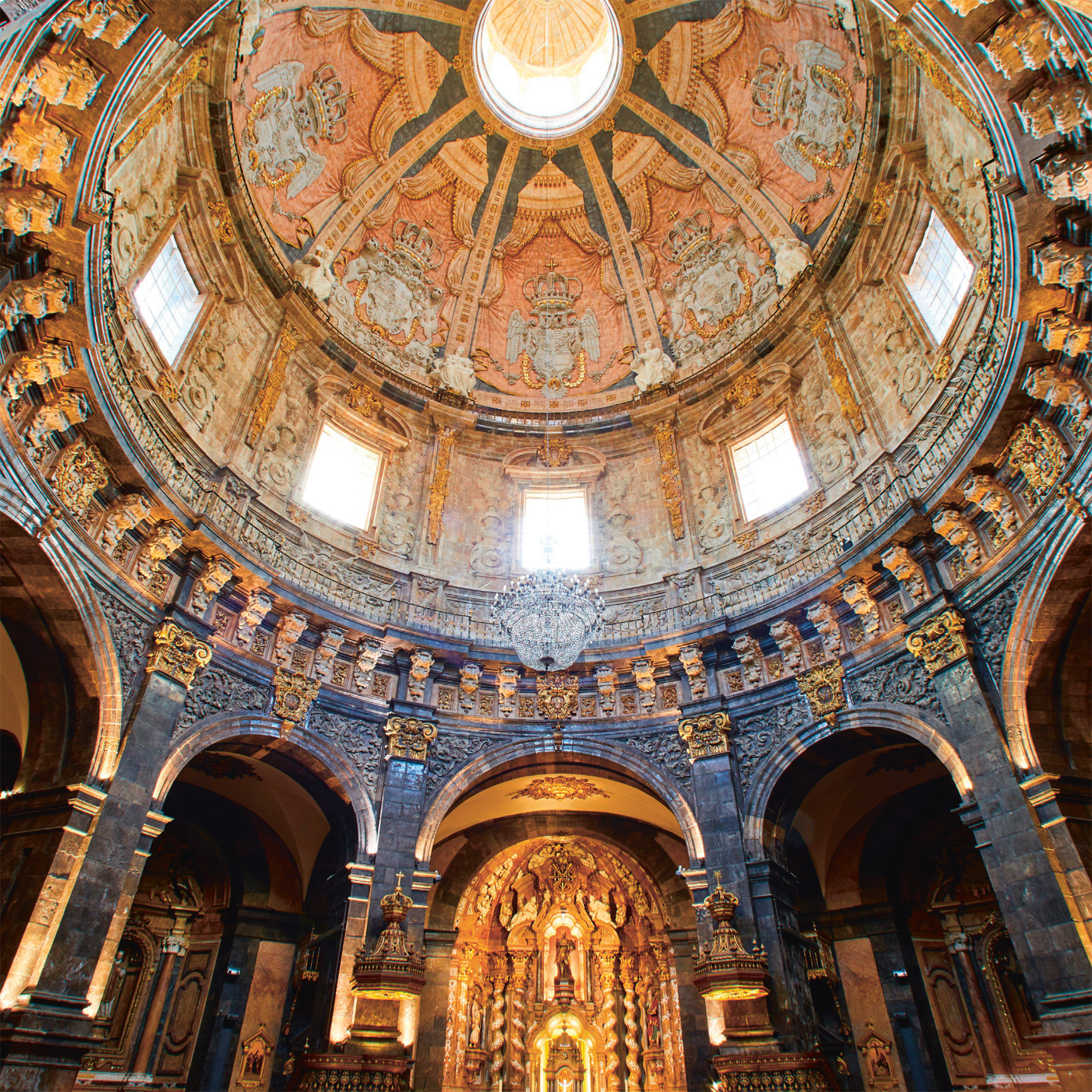
t A Churrigueresque cupola
The Founding of the Jesuit Order
The Society of Jesus was founded in Rome in 1539 by Saint Ignatius and a group of priests who were dedicated to helping the poor. Pope Paul III soon approved the order’s establishment, with Ignatius as Superior General. The order, which grew very wealthy, vowed military obedience to the pope and became his most powerful weapon against the Reformation. Today, there are approximately 20,000 Jesuits working, mainly in education, in 112 countries.
The small town of Villanañe hosts a beautiful example of medieval civil architecture, the tower and mansion of the Verona family. Set on a hill, this imposing structure is the the best-preserved 14th-century fortified military building in the region. It now houses a museum displaying original furniture. The upper rooms are decorated with colourful 17th-century wallpaper, which replaced the tapestries that previously hung on the walls. Some of the floors are wood, while others are tiled with tiles, decorated with scenes from Don Quixote.
On the A2622 Pobes–Tuesta road are the Salinas de Añana, a group of saltpans fed by mineral springs. The nearby village of Tuesta has a Romanesque church, where the capitals are carved with historical scenes. There is also a medieval wood sculpture of St Sebastián.
This historic town in the Udana Valley has a distinguished past. In the First Carlist War (1833–9) it was a seat of the court of Don Carlos, brother of King Fernando VII and pretender to the throne. Its Universidad de Sancti Spriritus, built in about 1540, was for centuries the only one in the Basque Country. It has a Renaissance façade, decorated with statues of saints, and an elegant patio.
In the Plaza de los Fueros is the Gothic Iglesia de San Miguel, containing the tomb of Bishop Zuázola of Ávila, the founder of the university.
A mountain road ascends 9 km (6 miles) to the Santuario de Arantzazu, below the peak of Aitzgorri. In 1469 it is believed that a shepherd saw the Virgin here. Over the door of the church, built in the 1950s, are sculptures of the apostles by Jorge Oteiza.
" '
Universidad de Sancti Spiritus
⌂ Avenida de la Universidad Vasca § 943 78 34 53 # Daily for guided tours (phone Oñati tourist information in advance)

t Galleried courtyard of the former Basque Universidad de Sancti Spiritus in Oñati
EXPERIENCE The Basque Country, Navarra and La Rioja
|
Eat Bar Benigno Great pintxos and tapas – all homemade by the friendly owners – are on offer at this laid-back eatery in Haro. ⌂ Calle Navarra 1, Haro § 629 12 58 52 ¡¡¡ |
Set among extensive vineyards on the Río Ebro, the graceful town of Haro is the capital of the Rioja Alta wine region. The town’s main monument is a baroque basilica devoted to its patron saint, Nuestra Señora de la Vega – there’s a Gothic figure of her on the high altar, but the hilltop Iglesia de Santo Tomás is also of note. Check out the Plateresque portal, which was designed as an altar and depicts scenes from the cross.
But Haro’s real highlight is its wine. The clay soil and the climate – the town is sheltered by a sierra to the north – create perfect vine-growing conditions. Sample the area’s famous grapes at one of the town’s many bodegas. Several of them offer tours and tastings (book in advance; a small fee may apply). But you can also savour a glass – or two – at one of the charming cafés in the Old Town, which offer local wines and tapas at low prices and a convivial atmosphere.
The town is so enamoured by its grapes that it is celebrated in its annual fiesta at the end of June (see Regional Fiestas).
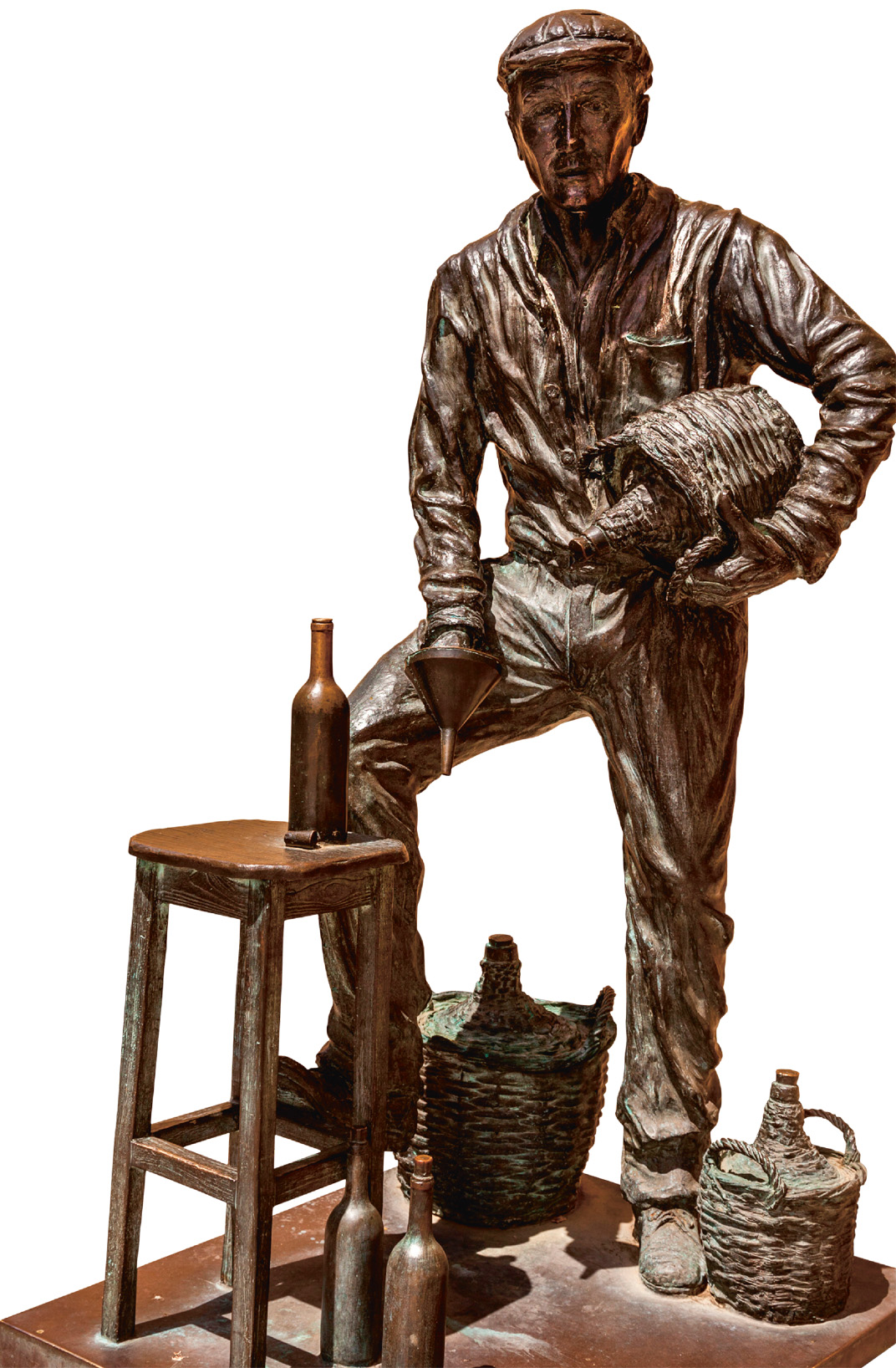
t Bronze statue depicting stages of the wine-making process, Haro
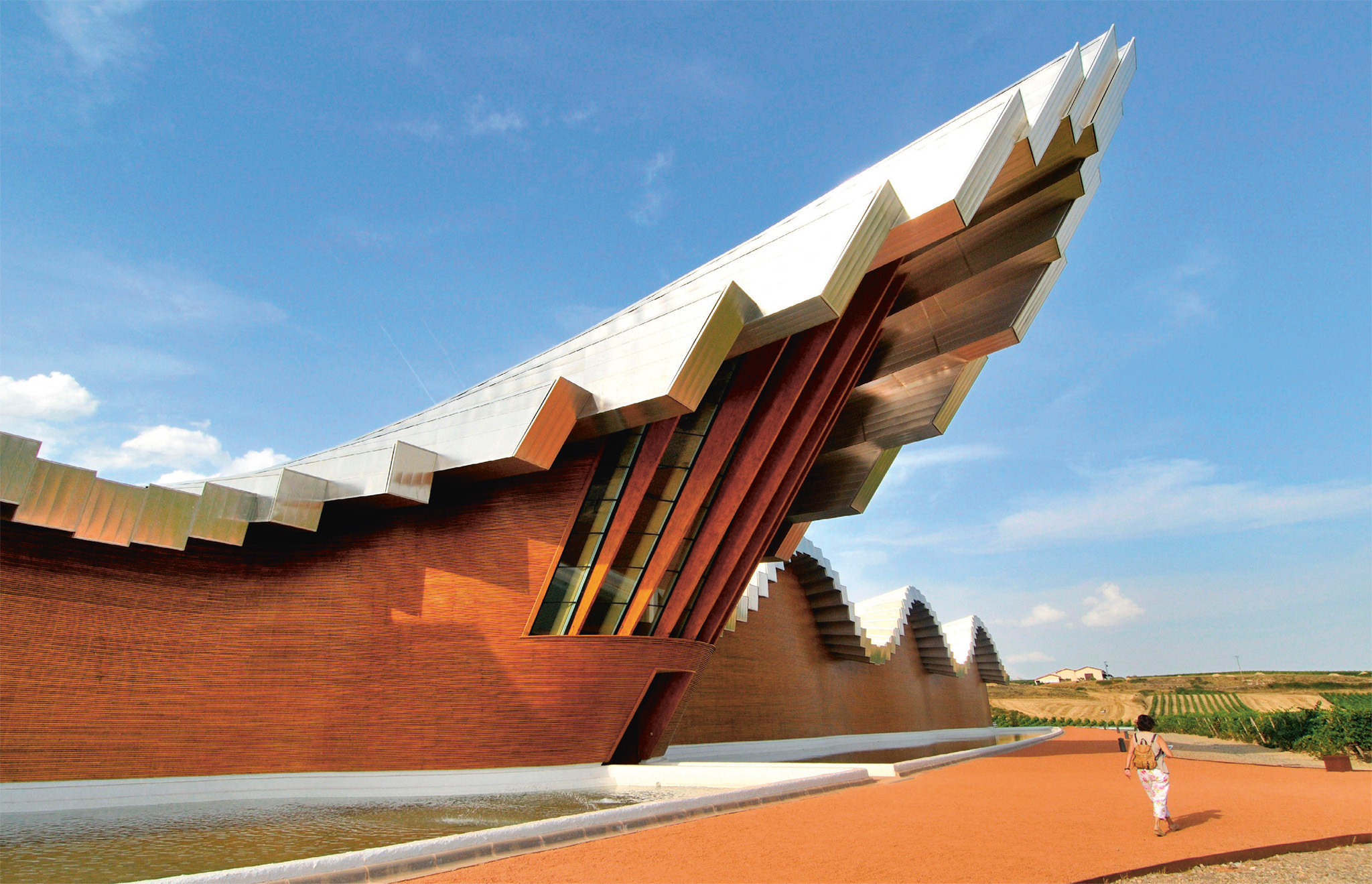
t Bodega Ysios near Laguardia, one of many bodegas found in this wine-producing region
This little wine town is the capital of La Rioja Alavesa, a part of southern Álava province where Rioja wines have been produced for centuries. It is a fertile, vine-clad plain, sheltered by high hills to the north. There are fine panoramic views from the road that climbs up to the Herrera pass. Laguardia is a medieval hill town, its encircling ramparts, towers and fortified gateways visible from afar. Along its steep, narrow cobbled streets there are many bodegas (wine cellars), offering wine tastings and tours throughout the year. It is usually necessary to make a booking in advance. In Plaza Mayor, the main square, you can see the old 16th-century town hall and the newer 19th-century building that serves as the current town hall. The Gothic Iglesia de Santa María de los Reyes is well worth a visit, with its austere façade and a richly embellished inner portal that has retained its original colouring. Another church worth seeing is the Iglesia de San Juan Bautista, a 12th-century building built as a temple-fortress. The majority of the church was built in the Gothic style in the 13th and 14th centuries, and modifications in the 16th century reduced its fortress-like appearance. It now houses a museum of liturgical objects.
A walkable distance from Laguardia is the Poblado de la Hoya, a prehistoric excavation sight that explores the history of the Celtiberian peoples that once lived in the area.

Picture Perfect
Through the Keyhole
Pose in front of the intricate double doorway to Laguardia’s Santa María de los Reyes church. If you turn up the contrast, you’ll capture the vibrant detail on its colourful sculptures.

t Plaza de la Virgen Blanca, with the Iglesia de San Miguel at the far end, Vitoria
Vitoria (Gasteiz), the seat of the Basque government, was founded on the site of an ancient Basque town, Gasteiz. Vitoria’s oldest part, El Campillo, was rebuilt in 1200 after a fire. The city later grew rich on the iron and wool trades.
The Old Town focuses on the Plaza de la Virgen Blanca, with its monument to a battle fought nearby in 1813, when the British Duke of Wellington defeated the French. Around the plaza are old houses with miradores (glazed balconies).
Presiding over the plaza is the Gothic Iglesia de San Miguel. An outside niche contains a statue of the Virgen Blanca (White Virgin), Vitoria’s patron saint. A big festival starts before her feast day, which is on 5 August. On the wall of San Miguel facing the Plaza del Machete there is a recess with a replica of the machete on which the city’s rulers swore to uphold the laws or be slain.
The Old Town has several Renaissance palaces, including the 16th-century Palacio de Escoriaza-Esquibel, with its Plateresque patio. Around it is a charming area of alleys linked by steep steps.
The city has two cathedrals. The oldest is the Gothic Catedral de Santa María, with a sculpted west porch. Close by, in Calle Correría, a street of old houses, is El Portalón, a merchant’s house and hostel from the 15th century. The building, which is full of Basque Country furniture and art, is now a restaurant.
Among the city’s later architectural gems are an arcaded street, Los Arquillos, and the adjoining Plaza de España, also arcaded. They were built in the late 18th century to link the Old Town with the new quarter then being built. South of the Old Town is the Neo-Gothic Catedral Nueva de María Inmaculada, begun in 1907 and finished in 1973.
Located in the centre of Vitoria’s Old Town is Artium, the Basque Museum of Contemporary Art. It occupies a striking white building and contains one of Spain’s largest collections of modern and contemporary art, which is displayed over three large rooms. The focus of the permanent collection is mainly on Spanish artists like Dalí, Miró, Tàpies and Chillida.
The Museo de Arqueología y Naipes has 1,500 pieces, including prehistoric artifacts and Roman sculptures found at Álava. Visitors can experience multimedia projections and sound effects. The grandson of Heraclio Fournier, who founded a playing cards factory in Vitoria in 1868, also displays his collection of more than 6,000 items in this museum. The oldest exhibits are late 14th-century Italian cards. Among the many sets of tarot cards are some designed by Salvador Dalí in the 1980s.
" '
Artium
⌂ Calle de Francia 24 # 11am–2pm & 5–8pm Tue–Fri, 11am–8pm Sat & Sun ∑ artium.org
Museo de Arqueología y Naipes (BIBAT)
⌂ Palacio de Bendaña, Calle Cuchillería 54 § 945 20 37 00 # 10am–2pm & 4–6:30pm Tue–Sat, 11am–2pm Sun
Did You Know?
Vitoria’s mascot is El Caminante – a statue of a slender man walking through the Plaza del Arca.
Basque Culture
The Basques may be Europe’s oldest race, thought to have descended from Cro-Magnon people who lived in the Pyrenees 40,000 years ago. The dolmens and carved stones of their ancestors are evidence of the Basques’ pagan roots. Long isolated in their mountain valleys, the Basques preserved their unique language, myths and art for millennia. Many families still live in the chalet-style stone caseríos, or farmhouses, built by their forebears. Their music and high-bounding dances are unlike those of any other culture, and their cuisine is varied and imaginative. The fueros, or ancient Basque laws and rights, were suppressed under General Franco, but since the arrival of democracy in 1975 the Basques have had their own parliament and police force, having won great autonomy over their own affairs.
EXPERIENCE The Basque Country, Navarra and La Rioja
|
Drink La Rioja is home to some of the country’s most famous wineries. Here are our favourites. Marqués de Riscal ⌂ Calle Torrea 1, Elciego ∑ marquesderiscal.com Bodegas Franco-Españolas ⌂ Calle Cabo Noval 2, Logroño ∑ francoespanolas.com Bodegas Ruiz de Viñaspre ⌂ Camino de la Hoya s/n, Laguardia ∑ bodegaruizdevinaspre.com Bodegas Ysios ⌂ La Hoya Bidea s/n, Laguardia ∑ bodegasysios.com Vivanco ⌂ Carretera Nacional 232, Briones ∑ vivancoculturadevino.es |
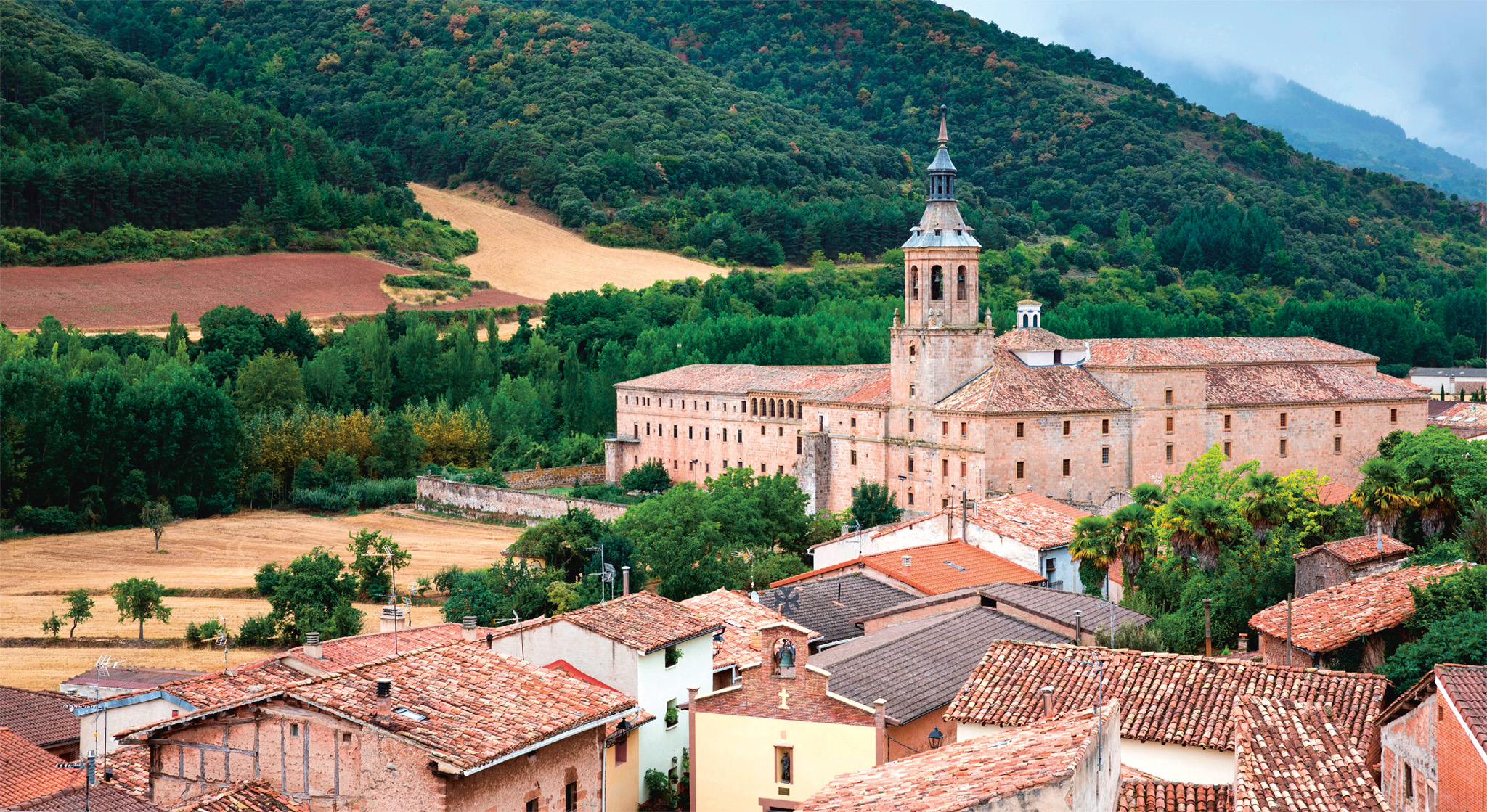
t The Monasterio de San Millán de Yuso, superbly set in the Cárdenas Valley
People only really visit this village for its twin monasteries. The first of these is the Monasterio de San Millán de Suso, which stands on a hillside above San Millán de la Cogolla (“Suso” means upper). It was built in the 10th century on the site of a community founded by St Emilian, a shepherd hermit, in AD 537. The pink-sanstone church contains the tomb of St Emilian and the graves of seven infants who, according to legend, were kidnapped and beheaded by the Moors.
The Monasterio de San Millán de Yuso (“Yuso” means lower) is in the valley below. It was built between the 16th and 18th centuries. Look out for the ivory plaques in the treasury. They were once part of two 11th-century jewelled reliquaries, which were plundered by French troops in 1813.
" '
Monasterio de San Millán de Suso
# Book ahead ∑ monasteriodeyuso.org
" '
Monasterio de San Millán de Yuso
# Easter–Sep: 10am–1:30pm & 4–6:30pm Tue–Sun; Oct–Easter: 10am–1pm & 3:30–5:30pm Tue–Sat, 10am–1pm Sun ∑ monasteriodeyuso.org
The Old Town of Nájera was the capital of La Rioja and Navarra until 1076, when La Rioja was incorporated into Castile. The royal families of Navarra, León and Castile are buried in the Monasterio de Santa María la Real. This monastery was founded in the 11th century beside a sandstone cliff where a statue of the Virgin was found in a cave. Today, a 13th-century Madonna stands in the cave.
"
Monasterio de Santa María la Real
⌂ Plaza Santa María 1, Nájera # Apr–Oct: 10am–1:30pm & 4–7pm Tue–Sat, 10am–1:30pm & 4–6pm Sun; Nov–Mar: 10am–1:30pm & 4–5:30pm daily ∑ santamarialareal.net
This town on the Camino de Santiago is named after the 11th-century saint who built bridges and calzadas (roads) to help pilgrims. Santo Domingo also founded a hospital, which now serves as a parador.
Miracles performed by the saint are recorded in carvings on his tomb in the town’s part-Romanesque, part-Gothic cathedral, and in paintings on the wall of the choir. The most obvious and bizarre record is a sumptuously decorated cage set in a wall in which, for centuries, a live cock and hen have been kept. The cathedral has a carved walnut reredos at the high altar, the last work, in 1541, of the artist Damià Forment. The restored 14th-century ramparts of the town are also worth seeing.
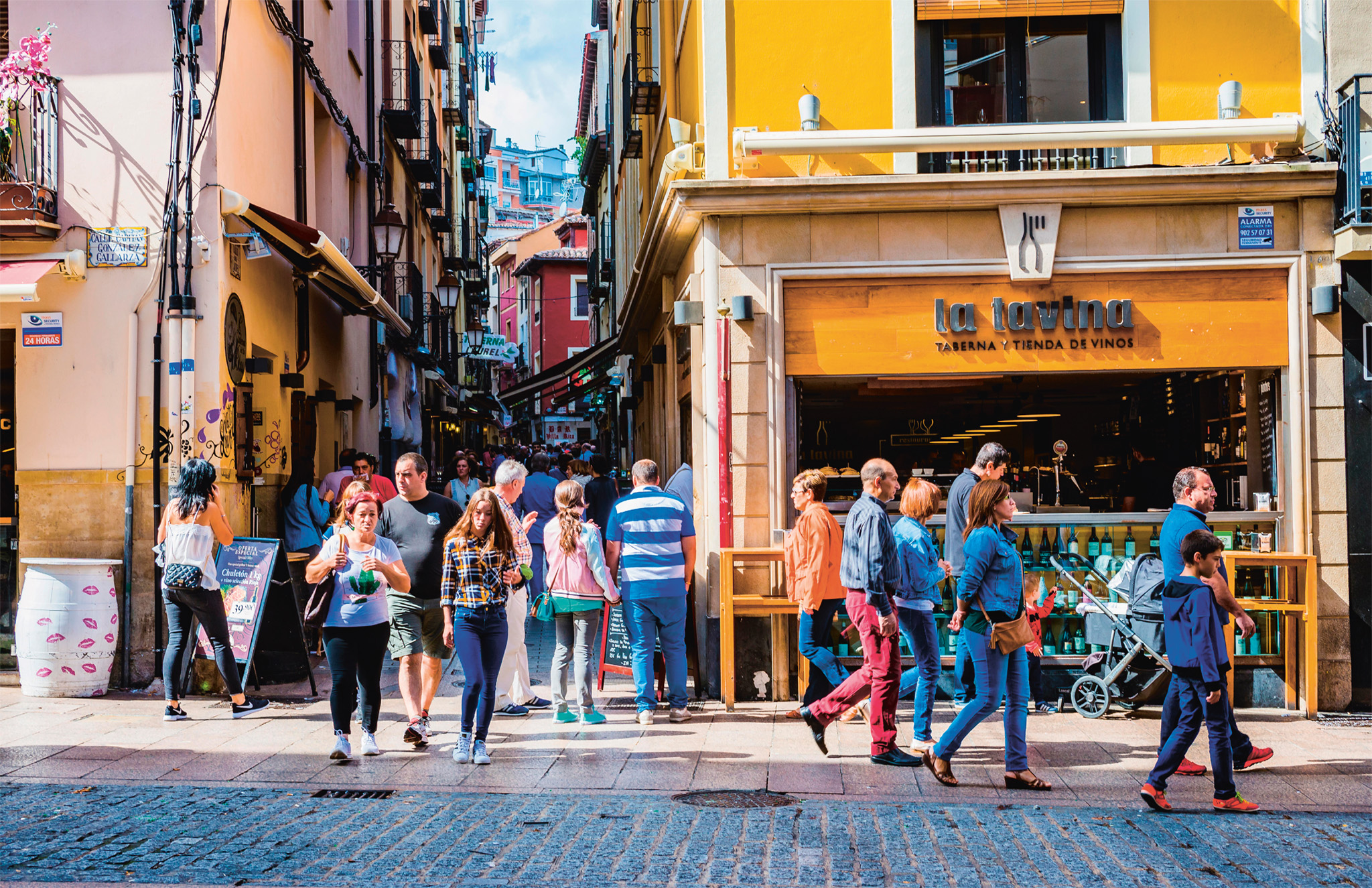
t Always bustling with people, the narrow Calle Laurel in Logroño
The capital of La Rioja is a tidy, modern city of wide boule-vards and smart shops. It is the commercial centre of a fertile plain where quality vegetables are produced, in addition to Rioja wines. In Logroño’s pleasant old quarter on the Río Ebro is the Gothic cathedral, with twin towers. Above the south portal of the nearby Iglesia de Santiago el Real, which houses an image of the patron saint Our Lady of Hope, is an equestrian statue of St James (Santiago).
About 50 km (30 miles) south of Logroño, the N111 twists and turns through the dramatic Iregua Valley to the Sierra de Cameros.
EXPERIENCE The Basque Country, Navarra and La Rioja
The Cock and Hen of Santo Domingo
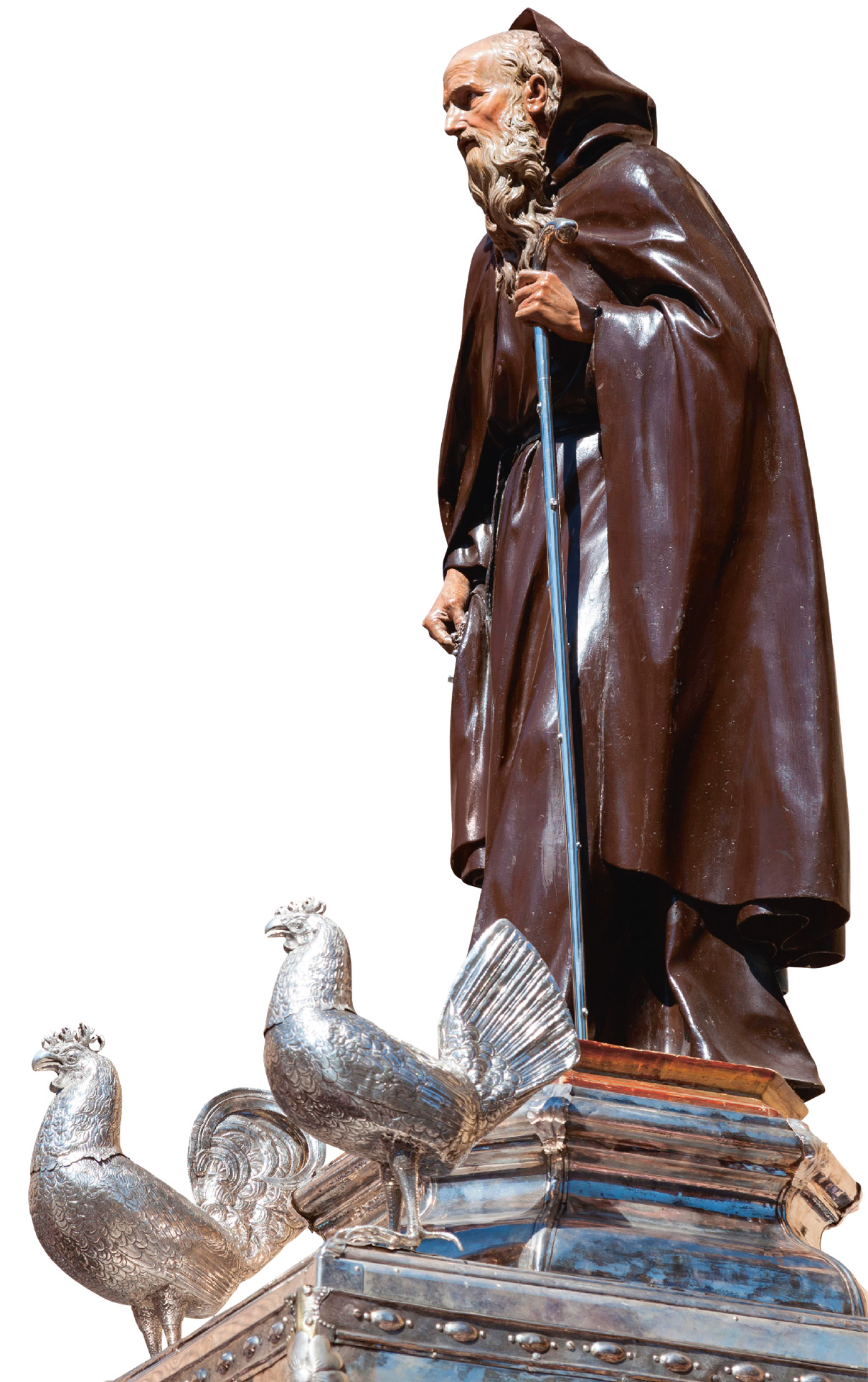
A live cock and hen are kept in the cathedral of Santo Domingo de la Calzada as a tribute to the saint’s miraculous life-giving powers. Centuries ago, it is said, a German pilgrim refused the advances of a local girl, who denounced him as a thief. He was hanged as a consequence, but later his parents found him alive on the gallows. They rushed to a judge, who said, dismissively, “Nonsense, he’s no more alive than this roast chicken on my plate.” Whereupon, the chicken stood up on the plate and crowed.
DISCOVER The Basque Country, Navarra and La Rioja

Regional Fiestas
Fiesta del Santo
From 10 to 15 May, Santo Domingo de la Calzada celebrate their patron saint with colourful dances and fun processions.
Wine Battle
On 29 June, people in white clothes squirt each other with wine from drinking bottles in Haro, capital of the Rioja Alta region.
Danza de los Zancos
Dancers on stilts, wearing fancy waistcoats and yellow skirts, hurtle down the steps from Anguiano’s church to the main square on 22 July and the last Saturday of September. No one knows why.
La Virgen Blanca
In Vitoria on 5 August, to honour the Virgin Mary, a dummy holding an umbrella is lowered from San Miguel church to a house below – from which a man in similar dress emerges.
French Cistercian monks built this small monastery on a remote plain in the 1100s. The church is adorned with rose windows and has a 17th-century tower. The serene cloister, dating from the 14th and 15th centuries, adjoins a 12th-century chapterhouse.
Today, the monks survive by selling local honey and cheese, their own wine, and by accepting paying guests.
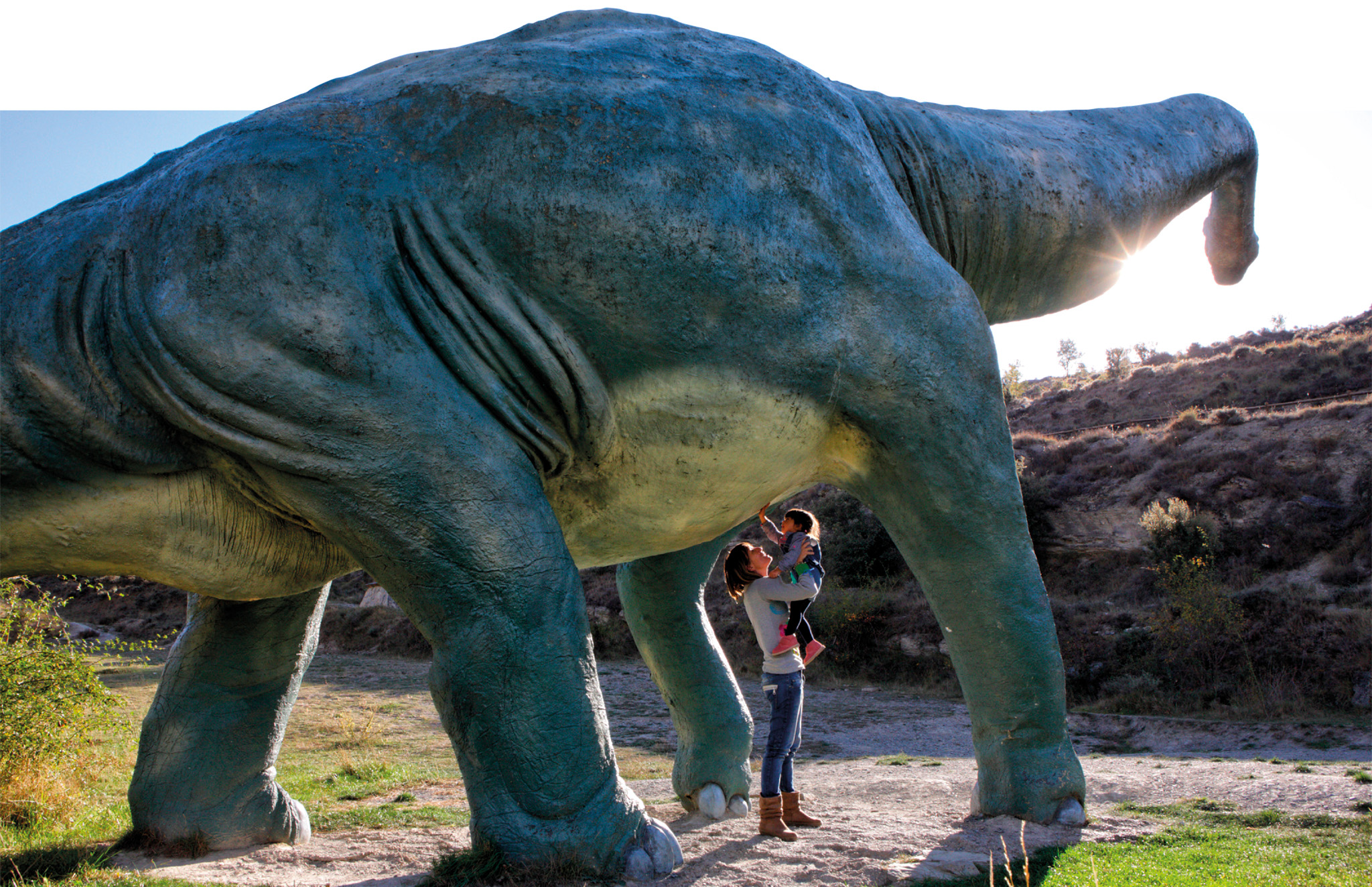
t Dinosaur statue marking the spot where these creatures once roamed in Enciso
Near this remote hill village west of Calahorra is Spain’s “Jurassic Park”. Signposts point to the huellas de dinosaurios (dinosaur footprints). Embedded in rocks overhanging a stream are the prints of many giant, three-toed feet, up to 30 cm (1 ft) long. They were made around 150 million years ago, when dinosaurs moved between the marshes of the Ebro Valley, at that time a sea, and these hills. Prints can also be seen at other locations in the area.
Arnedillo, 10 km (6 miles) to the north of Enciso, is a spa with thermal baths once used by Fernando VI. In Autol, to the east, there are two unusual limestone peaks.
An unspoiled hill village, Ujué commands a high spur at the end of a winding road. The village is a charming maze of cobbled alleys and steep steps.
The impressive and austere Iglesia de Santa María is in Gothic style, featuring a Romanesque chancel and an exterior lookout gallery. The ruined fortifications around the church offer extensive views of the Pyrenees.
On the Sunday after 25 April, pilgrims in black capes visit the Virgin of Ujué, whose image is displayed in the church.
Navarra’s second city is the great commercial centre of the vast agricultural lands of the Ebro Valley, known as the Ribera. Much of Tudela consists of modern developments, but its origins are ancient. Spanning the Ebro is a 13th-century bridge with 17 irregular arches. The Old Town has two well-preserved Jewish districts.
The Plaza de los Fueros is old Tudela’s main square. It is surrounded by houses with wrought-iron balconies. On some of their façades are paintings of bullfights, a reminder that the plaza was formerly used as a bullring.
The cathedral, begun in 1194, exemplifies the religious toleration under which Tudela was governed after the Reconquest. It is Early Gothic, with a carved portal depicting the Last Judgment and a Romanesque cloister. Beside the cathedral is a 9th-century chapel that is thought to have been a synagogue.
To the north is the Bárdenas Reales, an arid area of limestone cliffs and crags. This desert-like landscape is the result of hot summers, cold winters and long dry periods interrupted by heavy rain.
About 20 km (12 miles) west of Tudela is the spa town of Fitero, with the 12th-century Monasterio de Santa María.

t A street in Tudela, with sand-coloured houses and the cathedral tower behind
EXPERIENCE The Basque Country, Navarra and La Rioja
The Kingdom of Navarra

Navarra emerged as an independent Christian kingdom in the 10th century, after Sancho I Garcés became king of Pamplona. It became a formidable force as Sancho III the Great expanded the kingdom, and at his death, in 1035, Navarra stretched all the way from Ribagorza in Aragón to Valladolid. But the kingdom’s autonomy was not to last. In 1234, Navarra passed by marriage to a line of French rulers. But, one, Carlos de Viana (below), wrote The Chronicle of the Kings of Navarra in 1455, which lauded his predecessors. In 1512 Navarra was annexed by Fernando II of Castile and became part of Spain as we know it, but it kept its own laws and currency until the 1800s.

t The pilgrims’ bridge over the Río Arga at Puente la Reina
Few towns along the Camino de Santiago evoke the past as vividly as Puente la Reina. The town takes its name from the graceful, humpbacked pedestrian bridge over the Río Arga. The bridge was built for pilgrims during the 11th century by royal command.
On Puente la Reina’s narrow main street is the Iglesia de Santiago, which has a gilded statue by the west door showing the saint as a pilgrim. On the edge of town is the Iglesia del Crucifijo, another pilgrim church which was built in the 12th century by the Knights Templar. Contained within the church is a Y-shaped wooden crucifix of a sorrowful Christ with arms upraised, which is believed to have been a gift from a German pilgrim in the 14th century.
Isolated in the fields about 5 km (3 miles) to the east is the 12th-century Iglesia de Santa María de Eunate. This octagonal Romanesque church is fringed by a remarkable cloister, with many arches, which may have given the church its name – in Basque ehun atea means “one hundred doors”. West of Puente la Reina is the showpiece hill village of Cirauqui. It is also charming, if rather over-restored. Chic little balconied houses line tortuously twisting alleys linked by steps. The Iglesia de San Román, built in the 13th century on top of the hill, has a sculpted west door.
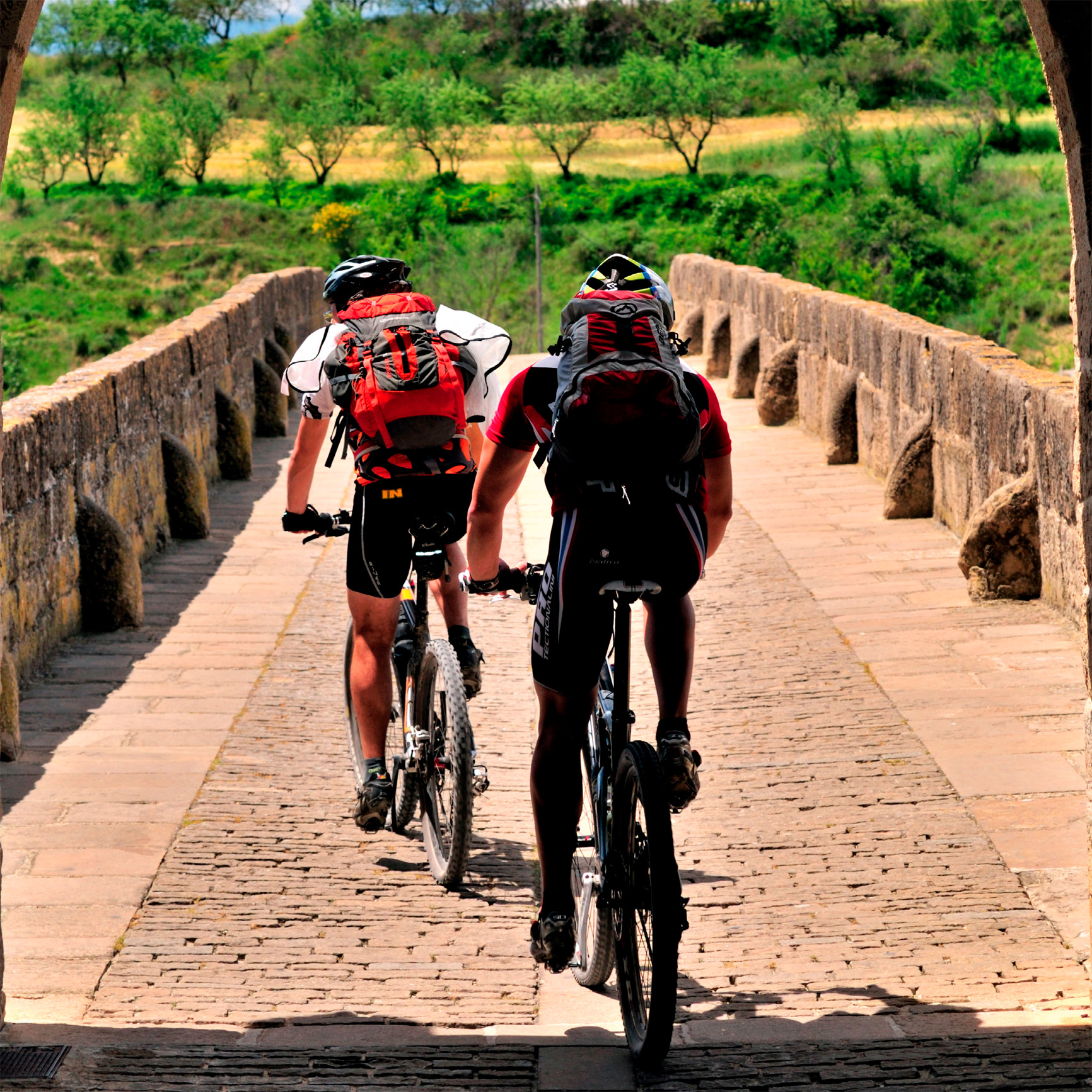
t Now used by cyclists
King Sancho Ramírez, who founded Estella (Lizarra) in the 11th century, ensured that the Camino de Santiago passed through the town and throughout the Middle ages it was the centre of the royal court of Navarra and a major stop on the pilgrimage.
The most important monuments in Estella are sited on the edge of town, across the bridge over the Río Ega. Steps climb steeply from the arcaded Plaza de San Martín to the remarkable Iglesia de San Pedro de la Rúa, built on top of a cliff from the 12th to 14th centuries. The carved capitals are all that now remain of the Romanesque cloister, which was destroyed when a castle overlooking the church was blown up in 1592. The Palacio de los Reyes de Navarra (now a museum), on the other side of the Plaza de San Martín, is a rare example of civil Romanesque architecture.
In the town centre, on Plaza de los Fueros, Iglesia de San Juan Bautista has a Romanesque porch. The north portal of the Iglesia de San Miguel has Romanesque carvings of St Michael slaying a dragon.
The Monasterio de Nuestra Señora de Irache, 3 km (2 miles) southwest of Estella, was a Benedictine monastery which sheltered pilgrims on their way to Santiago. The church is mainly Transitional Gothic in style, but it has Romanesque apses and a cloister in Plateresque style. It is capped by a remarkable dome. A bodega next to the monastery provides pilgrims with wine from a tap in a wall.
A small road branches off the NA120 north of Estella and leads to the Monasterio de Iranzu, built in the 12th to 14th centuries. The austerity of its church and cloisters is typically Cistercian.
The historic town of Olite was founded by the Romans and later chosen as a royal residence by the kings of Navarra. Parts of the town’s Roman walls can be seen but Olite is known as “the Gothic town” and abounds with examples of the architectural style.
In the 15th century, Carlos III set about constructing the monumental Palacio Real de Olite, regarded as a gem of Navarrese Gothic style. The palace was heavily fortified, but was brilliantly decorated inside with azulejos (ceramic tiles) and marquetry ceilings. The walkways were planted with vines and orange trees, and there was an aviary and a lions’ den. Further ediversion came from the tournaments held in the grounds, which monarchs could watch from the “windy tower”. The palace was burned down in the War of Independence to prevent it falling into French hands, but it was meticulously rebuilt in 1937. Today, part of the palace houses a parador but non-guests can still explore the palace’s courtyards, passages, large halls, royal chambers, battlements and turrets. Adjoining the castle is a 13th-century former royal chapel, the Iglesia de Santa María, with its richly carved Gothic portal.
Elewhere in Olite, the delightful jumble of steep, narrow streets and little squares shelter churches, delightful Baroque houses and, as you would expect from the Navarra wine region, scores of traditional bodegas.
" '
Palacio Real de Olite
⌂ Plaza de Carlos III § 948 74 00 35 # 10am–7pm daily (Jul & Aug: to 8pm)
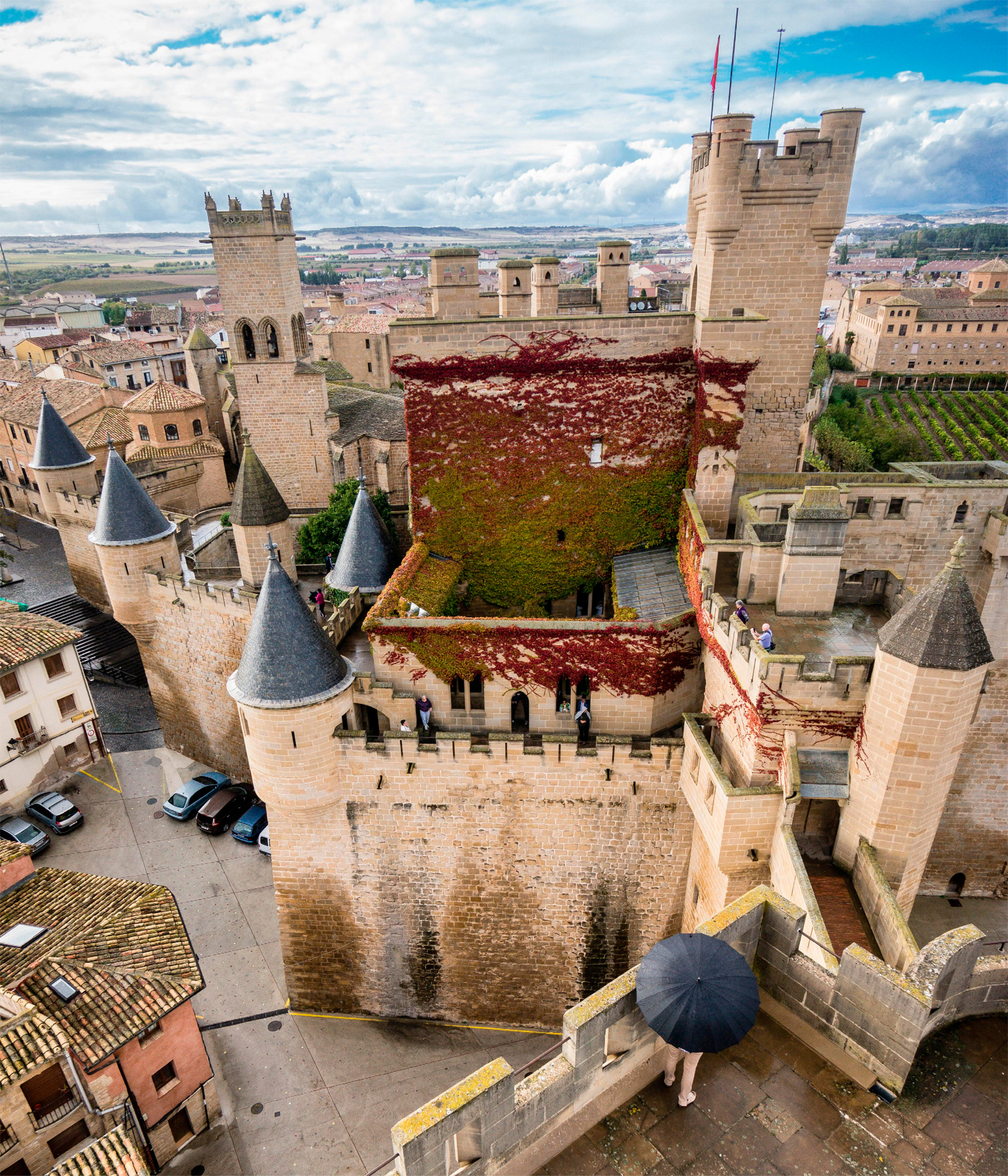
t The vast battlements and towers of the 15th-century Palacio Real de Olite
EXPERIENCE The Basque Country, Navarra and La Rioja
|
Stay Parador de Olite Set in the majestic 15th-century palace, the rooms at this parador have four-poster beds. ⌂ Plaza de Teobaldos 2, Olite ∑ parador.es ¡¡¡ Hotel Bed4U Tudela This basic but comfortable, well-presented hotel offers a budget stay without cutting corners. It is well located, close to Tudela. ⌂ Calle Canal de Mañeru s/n, Tudela ∑ bed4uhotels.com/tudela ¡¡¡ |
The old fortress city of Pamplona (Iruña) is said to have been founded by the Roman general Pompey. In the 9th century it became the capital of Navarra. But the city is best known for the fiesta of San Fermín, with its daredevil bull-running, held in July.
From the old city walls (murallas) you can get a good overview of Pamplona. The nearby cathedral, which is built in ochre-coloured stone, looks down on a loop in the Río Arga. It was built on the foundations of its 12th-century predecessor, and is mainly Gothic in style, with twin towers and an 18th-century façade. Inside there are lovely choir stalls and the alabaster tomb of Carlos III and Queen Leonor.
The southern entrance to the cloister is the beautifully carved, medieval Puerta de la Preciosa. The cathedral priests would gather here to sing an antiphon (hymn) to La Preciosa (Precious Virgin) before the night service.
The Museo Diocesano, housed in the cathedral’s 14th-century kitchen and refectory, has displays of Gothic altarpieces, polychrome wood statues from all over Navarra, and a French 13th-century reliquary of the Holy Sepulchre.
West of the cathedral is the Old Town, cut through with many alleys. The Neo-Classical Palacio del Gobierno de Navarra lies in the Plaza del Castillo and is the seat of the Navarrese government. Outside, a statue of 1903 shows a symbolic woman upholding the fueros (historic laws) of Navarra. North of the palace is the medieval Iglesia de San Saturnino, built on the site where St Saturninus is believed to have baptized some 40,000 pagan townspeople, and the Baroque ayuntamiento.
Beneath the Old Town wall, housed in a 16th-century hospital with a Plateresque doorway, is the Museo de Navarra. This is a museum of regional archaeology, history and art. Exhibits include Roman mosaics and an 11th-century, Islam-inspired ivory casket. There are murals painted during the 14th–16th centuries, a portrait by Goya and a collection of paintings by Basque artists.
To the southeast is the city’s massive 16th-century citadel, which was erected in Felipe II’s reign. It is designed with five bastions in a star shape. Beyond it are the spacious boulevards of the new town, and the city’s university.
'
Palacio del Gobierno de Navarra
⌂ Avenida Carlos III 2 § 848 42 71 27 # By appointment only
"
Museo de Navarra
⌂ Cuesta de Santo Domingo s/n § 848 42 64 93 # 9:30am–2pm & 5–7pm Tue–Sat, 11am–2pm Sun & public hols ¢ 1 Jan, 6 & 7 Jul, 25 Dec
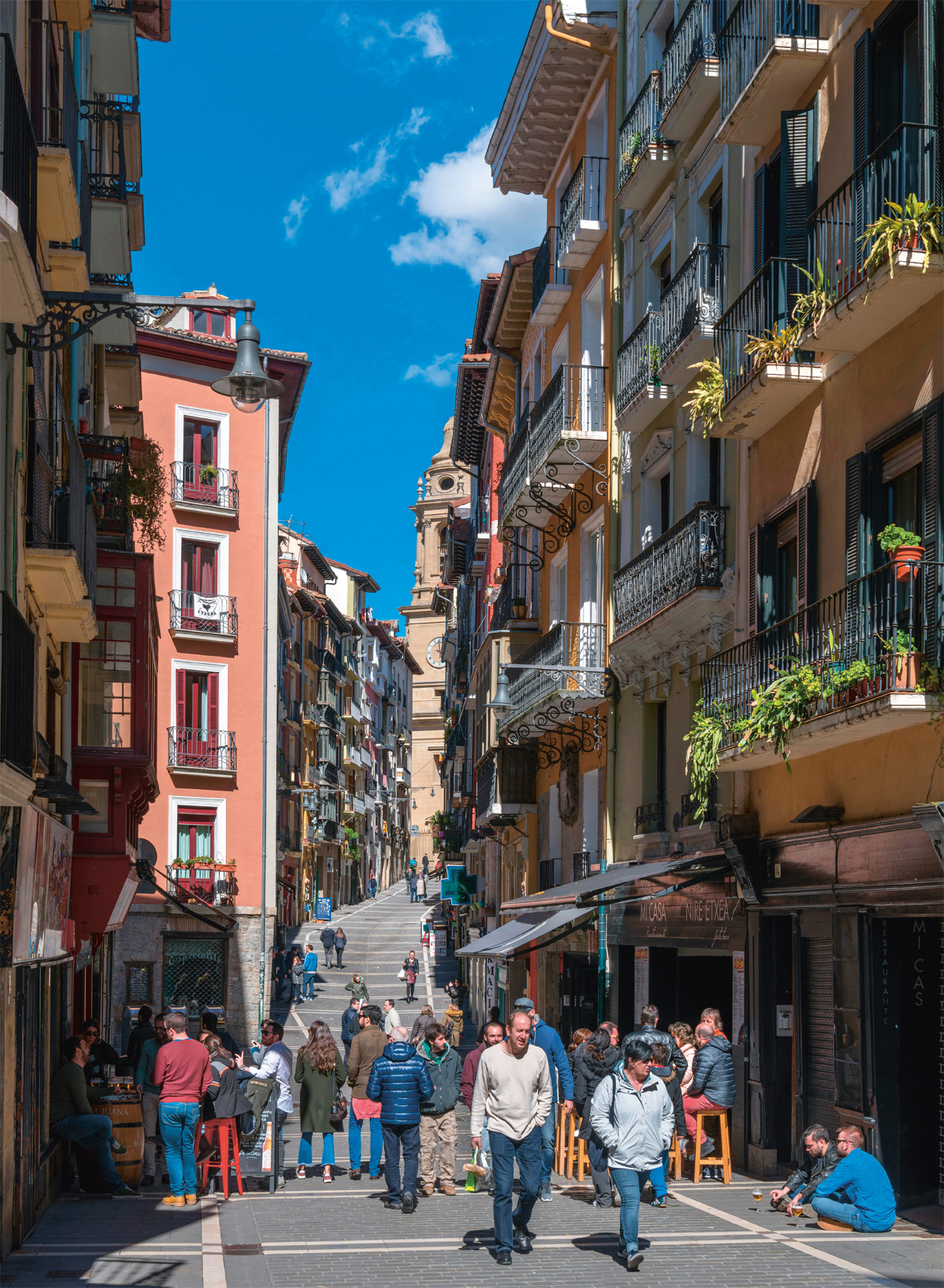
t Bars, shops and cafés on Calle Mercaderes, looking towards the cathedral in Pamplona
Did You Know?
Hemingway wrote that bull-running reminded him that “you don’t own” any day.
EXPERIENCE The Basque Country, Navarra and La Rioja
Running of the Bulls
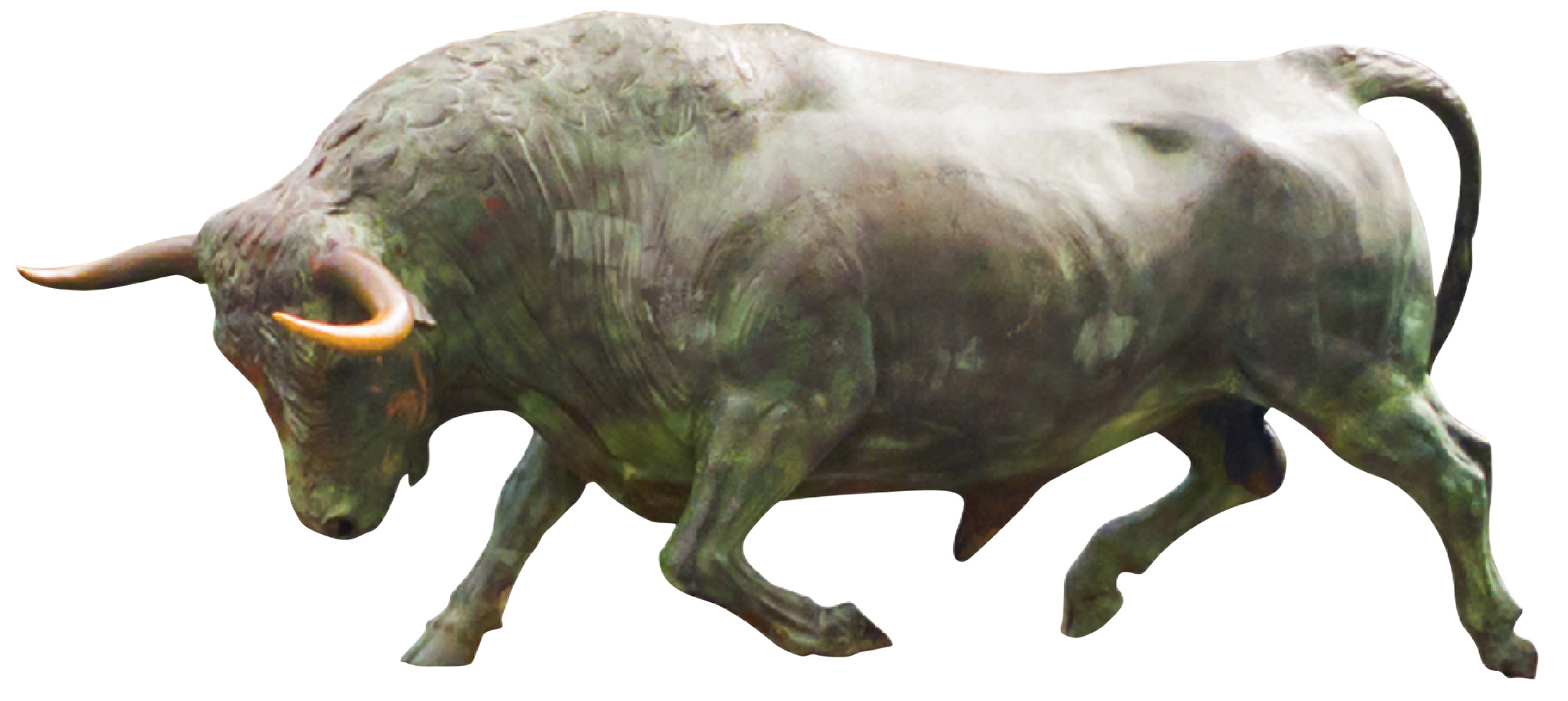
The encierro (running of the bulls) is a traditional Spanish event where a number of bulls are released into the streets, and people, often dressed all in white with red scarves around their waists and necks, try to outrun them. By far the most famous run is in Pamplona, which takes place during the San Fermín festival. Animal rights groups regularly protest against the event, as the bulls are often hurt or killed during or following the run.
This rural village lies in the middle of a beautiful valley, straddling the banks of the Baztán river. Named “beside the church”, Elizondo centres around the eclectic Iglesia de Santiago. Despite its Baroque appearance, this church was built in the 20th century.
The town of Zugarramurdi, further up the valley, is infused with the fragrance of herbs. Its most famous site is the Cuevas de Brujas. Witch sabbaths were said to have taken place here, and in 1609 the Inquisition tried 40 women from Zugarramurdi, accusing them of witchcraft. The site’s museum tells their story.
In the Bidasoa valley are five towns that owe their unique character to their proximity with France. The largest is Bera (Vera), home to the celebrated writer Pío Baroja. Heading south, you’ll come to Lesaka, where the houses have distinctive wooden balconies. The road south continues past hills dotted with white farmsteads to reach Igantzi (Yanci), the smallest of the towns.
Although Arantza is the most remote town, Etxalar (Echalar) seems the most frozen in time. Since the 12th century, pigeons have been caught in huge nets strung across a pass here.
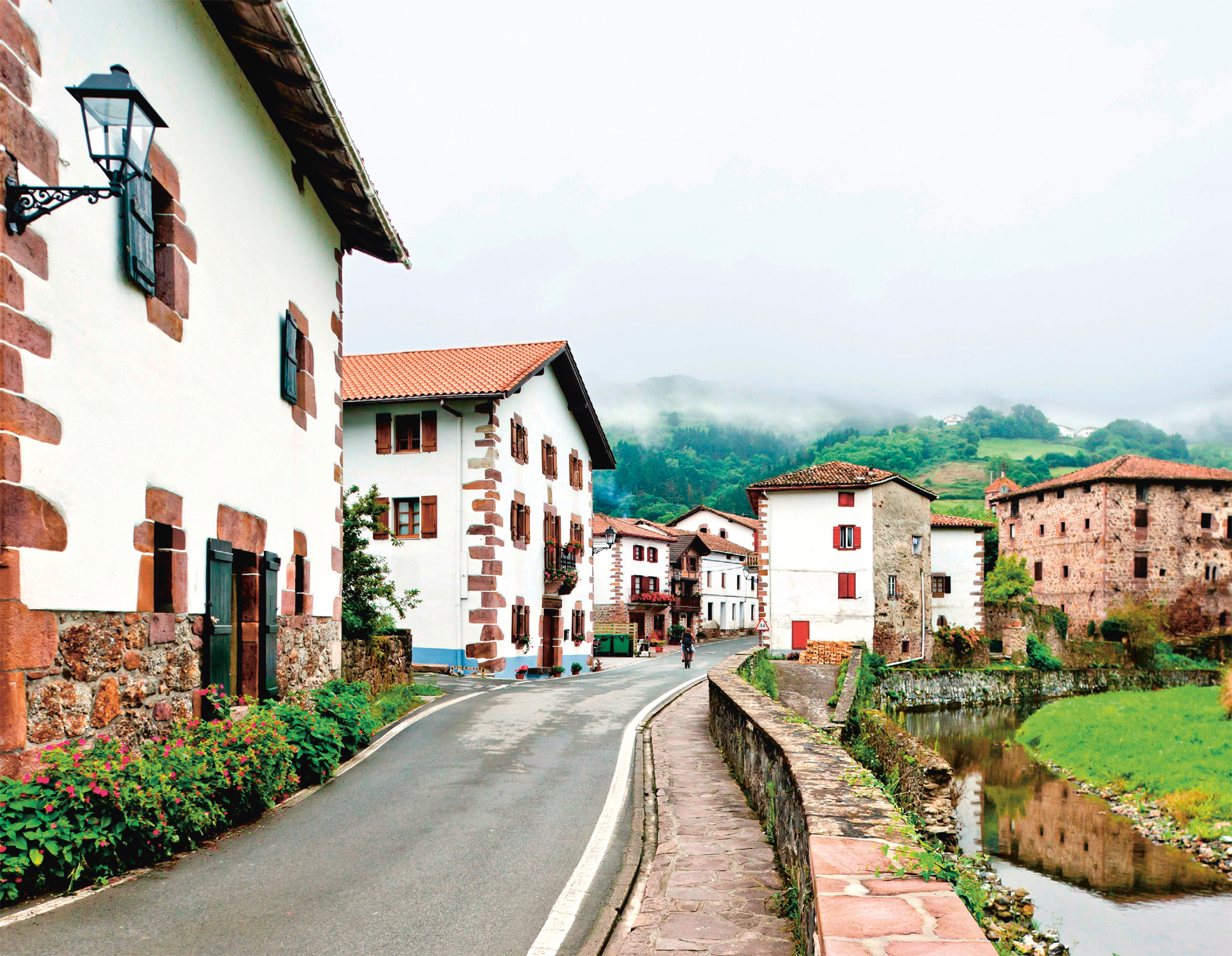
t Basque houses in the picturesque town of Etxalar, Valle de Bidasoa
Since medieval times this small town on the Río Aragón has been a popular stop on the Camino de Santiago.
The richly sculpted south portal of the Iglesia de Santa María la Real is a 12th- and 13th-century treasure of Romanesque art. It features several figures and details depicting the Last Judgment and society in the 13th century. The 12th- to 13th-century Gothic Iglesia de San Francisco and the Gothic Iglesia de Santiago are also worth seeing. The latter is decorated with symbols of the Camino, including scallop shells and walking sticks.
North of Sangüesa there are two deep, narrow gorges. The most impressive is the Hoz de Arbayún, whose limestone cliffs are inhabited by colonies of vultures. It is best seen from the NA178 north of Domeño. The Hoz de Lumbier can be seen from a point on the A21.

Great View
Reading La Rhune
The mountain of La Rhune stands high above the Valle de Bidasoa, straddling the border with France. Set off from Bera and follow the trail to its summit, where you will be rewarded by panoramic views of the Pyrenees.
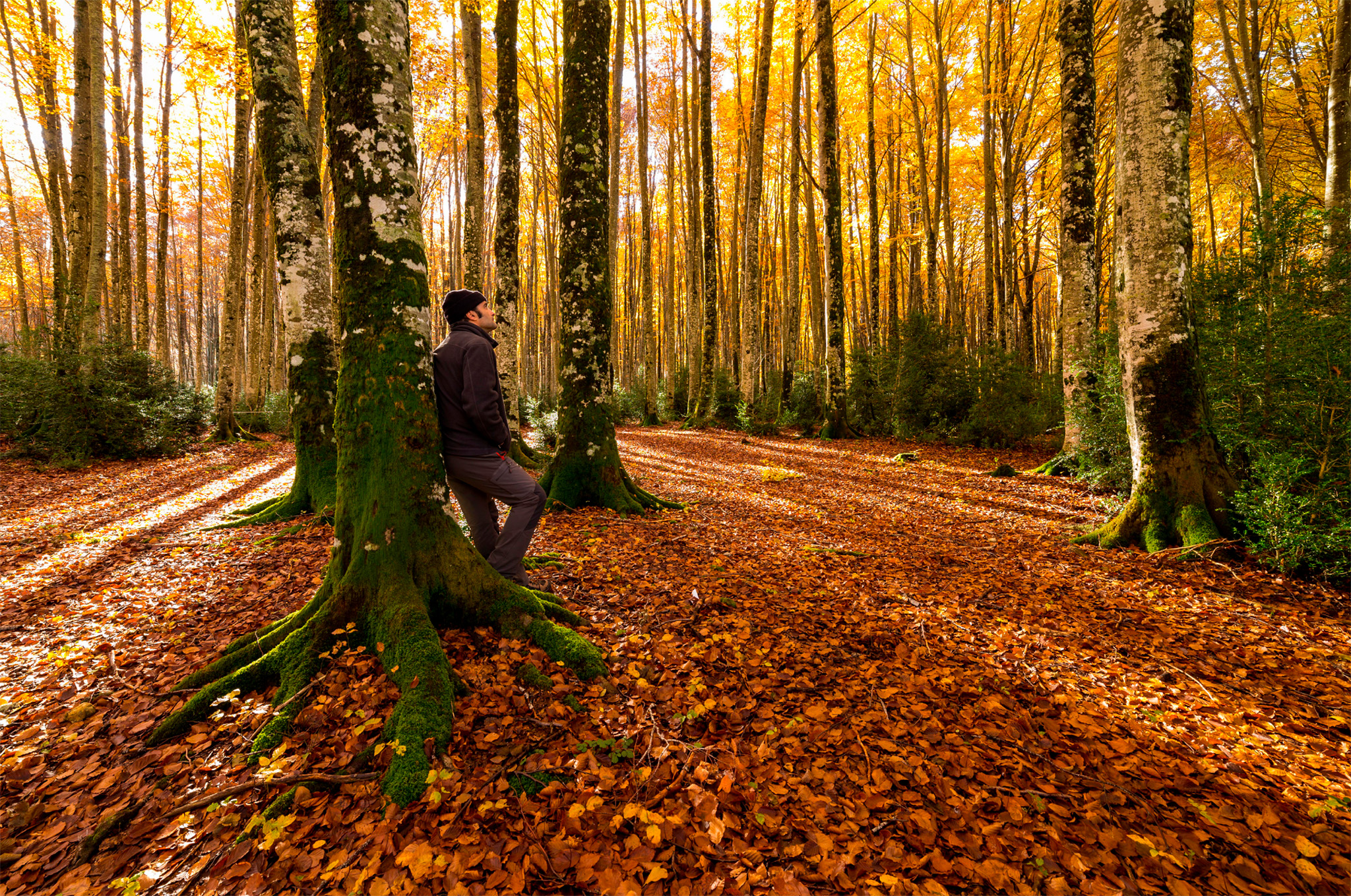
t Larra Belagua Forest, carpeted in autumn leaves, in the Valle de Roncal
Running perpendicular to the Pyrenees, this valley is mountainous part of Navarra and is home to the province’s loftiest peak – Mesa de los Tres Reyes, or Table of Three Kings. As you would expect from this landscape, the Valle de Roncal’s relies on farming – the village of Roncal is well known for its cheeses – and mountain pursuits.
The ski resort of Isaba, the largest town in the valley, has an interesting museum of local history and life. A spectacular road winds from Isaba to the tree-lined village of Ochagavia in the parallel Valle de Salazar. To the north, the Selva de Irati, one of Europe’s largest woodlands, spreads over the Pyrenees into France, below snowy Monte Ori at 2,017 m (6,617 ft).
DISCOVER The Basque Country, Navarra and La Rioja

Pintxo Dishes
La Gilda
Anchovy wrapped around guindilla peppers served with olives on either side.
Tortilla
Spanish omelette made with potato and onion.
Pintxo Pimiento Anchoa y Ajo
A piece of bread topped with red pepper, anchovy and garlic.
Stuffed peppers
Sweet piquillo peppers stuffed with salted cod.
Foie gras
Grilled foie gras, served with anything from jam to apples.
Roncesvalles (Orreaga), on the Spanish side of a pass through the Pyrenees, is a major halt on the Camino de Santiago. Before it became associated with the pilgrim’s way, Roncesvalles was the site of a major battle in AD 778, in which the Basques of Navarra slaughtered the rearguard of Charlemagne’s army as it marched homeward. This event is described in the 12th-century French epic poem The Song of Roland.
The 13th-century Colegiata Real, which has served travellers down the centuries, has a silver-plated Virgin and Child below a high canopy. In its chapterhouse is the white tomb of Sancho VII the Strong (1170–1234), which is looked down upon by a stained-glass window of his great victory, the battle of Las Navas de Tolosa. Exhibits displayed in the church museum include “Charlemagne’s chessboard”, an enamelled reliquary which is so called because of its chequered design.
The monastery of San Salvador de Leyre is situated high above a reservoir, alone amid grand scenery, backed by limestone cliffs. The abbey has been here since the 11th century, when it was a great spiritual and political centre. Sancho III and his successors made it the royal pantheon of Navarra. The monastery began to decline in the 12th century. It was abandoned from 1836 until 1954, when it was restored by the Benedictines, who turned part of it into a hotel. To see the monastery, you must join one of the tours run every morning and afternoon.
Time your visit to coincide with the monks’ Gregorian chant at 7:30am, 9am, 7pm or 9:10pm.
The large 11th-century church has a Gothic vault and three lofty apses. On its west portal are weather-worn carvings of strange beasts, as well as biblical figures. The Romanesque crypt has unusually short columns with chunky capitals.
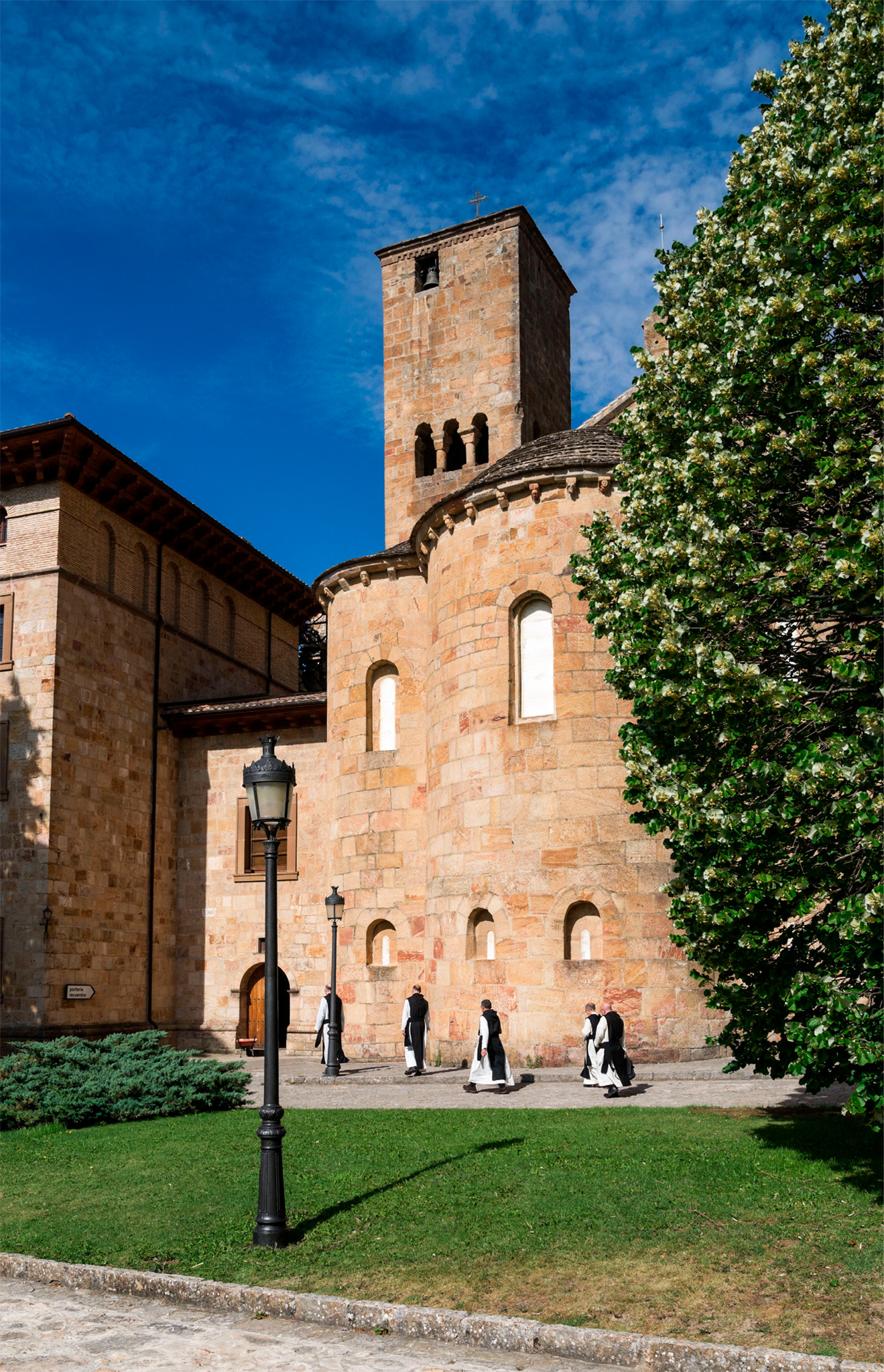
t Monks walking in the grounds of the Monasterio de Leyre
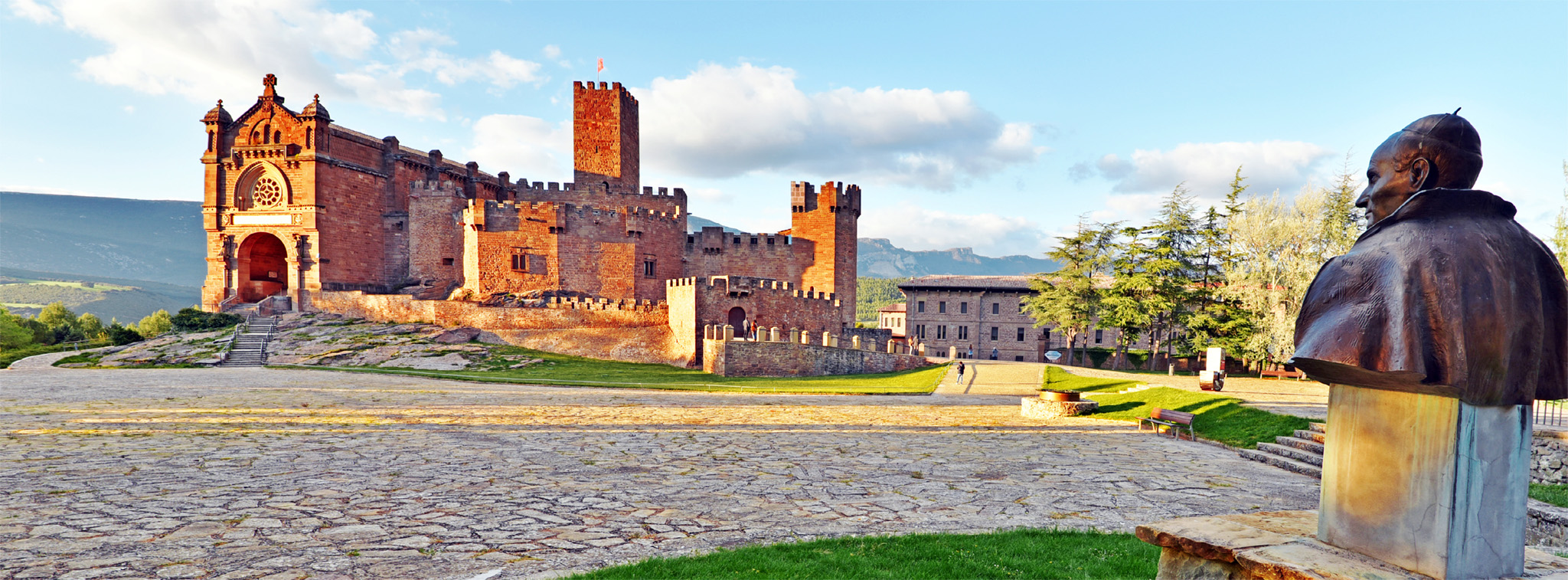
t The impressive hilltop Castillo de Javier, birth-place of St Francis Xavier
St Francis Xavier, patron saint of Navarra, was born in this 13th-century castle in 1506. It is now a Jesuit spiritual centre, but there is a museum in the keep devoted to his life. In the oratory is a macabre mural of grinning skeletons.
EXPERIENCE The Basque Country, Navarra and La Rioja
|
Eat Bar Gaucho Take a table outside at this bar and enjoy heaped pintxos. ⌂ Calle Espoz y Mina 7, Plaza del Castillo, Pamplona § 948 22 50 73 ¡¡¡ La Mandarra de la Ramos A vibrant pintxos bar; hanging Iberian hams give a Spanish feel. ⌂ Calle San Nicolas 9 Bajo, Pamplona ∑ lamandarradelaramos.com ¡¡¡ Casa Sabina This eatery in Roncesvalles offers a “pilgrim’s menu”. ⌂ Carretera Francia s/n, Roncesvalles ∑ casasabina.roncesvalles.es ¡¡¡ |
